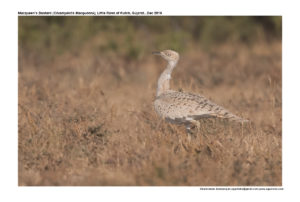Macqueens Bustard

Macqueen’s Bustard Chlamydotis macqueenii
Etymology:
- Chlamydotis : khlamus – horseman’s cloak with weights sewn into the corners ; otis -bustard.
- Macqueenii : Named after Major Thomas Macqueen (1792–1840)
Vernacular names: Baluchistan: Charz, Charas, Pushtu: Sara, Sare, Sind: Taloor, Raj: Tilor, Pun: Tiloor, Hobara, Obara, Guj: Houbara, Tilur, Kutch: Siara tiloor, Mal: Houbara, Marukkokku, Hindi, Mar: Hobara
Distribution in India: Winter Visitor in North West India
Description: Size of 65-75 cm. It is brown above and white below, with black stripes down the sides of the neck. In flight, the long wings show large areas of black and brown on the flight feathers and a white patch at the base of the primaries. From below the wing is mostly white with a black trailing edge. Macqueen’s bustard is very silent except for the sounds that males make in their display. Like other bustards, they have a flamboyant display, raising the white feathers of the head and throat and withdrawing the head while walking around a chosen lek site. Both sexes are nearly identical in plumage but males are slightly larger than females.
Habitat: It is found in arid sandy semi-desert with grass, flat bare stony plains dotted with xerophytic and halophytic scrub, wormwood steppe and sandy grasslands, often visiting marginal cultivation in non-breeding period.
Food Habits: This is a Variable and opportunistic feeder, with no clearly discernible seasonal or geographical pattern. Vegetable matter such as fruits, seeds, shoots, leaves and various invertebrates and small snakes and lizards. They do not drink water and obtain all the moisture they need from their diet
Breeding Habits: They breed in Mar- Apr. Males will call during display and if there are no potential mates, the display may be repeated. When a mate appears to be receptive, the male puffs up the black feathers on the sides of the neck so that it appears like a black collar or ruff and walks towards the female while twisting his body from side to side. The males mate with multiple females and after mating, the female alone builds the nest and incubates. Nest is a shallow unlined scrape on ground, sometimes in open but usually near some cover. There are 2–3 eggs in a clutch. Incubation is usually for 24 days. The eggs hatch after about 23 days and as in all bustards, the nidifugous chicks leave the nest immediately after hatching and follow the mother which picks insects and passes them to the chicks with her beak. The young fledge in about 30 days but remain close to their mother for several months. The male plays no part in parental care and a brood may include chicks sired by several different males. Young stay with female parent into first autumn.
When pursued by falcons, the bustard rises into the air and spirals to avoid being struck. It it also defends itself by defecating on the falcon, the sticky feces causing the falcon to crash to the ground with wings stuck.
This bird has been targeted as a game bird and shooting of these displaying birds has led to sharp declines in the populations in the past. Also the decline in the habitat due to human interference has made this species an “Endangered “species as per IUCN
.